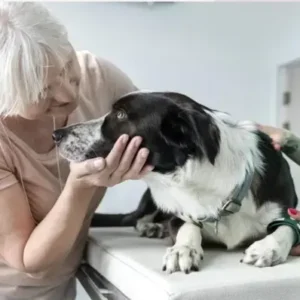Causes of Hip Dysplasia in Dogs
The primary cause of canine hip dysplasia is genetic. Dogs with a family history of the condition are likelier to develop hip dysplasia. However, environmental factors also play a significant role in the development and severity of hip dysplasia.
These include:
- Overfeeding: Excessive weight can stress the developing joints, worsening the condition.
- Rapid growth: Puppies that grow too quickly may have a higher risk in the long term.
- Improper exercise: While regular exercise is essential, overly strenuous activities during the puppy stage can contribute to joint problems.
- Hypothyroidism: Dogs with hypothyroidism often gain weight and lose muscle strength, which can strain their joints and worsen hip dysplasia.
Certain large breed dogs and giant dog breeds are genetically predisposed to hip dysplasia, including:
- German Shepherd
- Labrador Retriever
- Bulldog
- Tibetan Mastiff
- Saint Bernard
- Basset Hound
- Bloodhound
- Newfoundland
- Pit Bull
- Chow Chow
- Rottweiler
- Chesapeake Bay Retriever
Symptoms of Hip Dysplasia in Dogs
The symptoms and signs of hip dysplasia can vary depending on the severity of the condition and the dog’s age. Common clinical signs to watch for include:
- Decreased activity: Reluctance to run, jump, or climb stairs.
- Lameness: Limping or favoring one hind leg.
- Bunny hopping: Especially when climbing stairs.
- Stiffness: Difficulty getting up from a lying or sitting position.
- Pain: Whining or yelping when the hips are touched.
- Loss of muscle mass: Reduced muscle tone in the hind legs.
These symptoms often worsen with age, especially as arthritis sets in. Early detection is key to managing the condition effectively.
Diagnosing Hip Dysplasia in Dogs
If you suspect your dog may have hip dysplasia, a veterinary examination is necessary. Diagnosis typically involves:
- Physical examination: The vet will check for signs of pain, stiffness, and reduced range of motion in the hips.
- X-rays: Imaging is used to confirm the diagnosis and assess the severity of joint malformation.
- Joint manipulation: The vet may manipulate the hips to detect any looseness or grinding sounds.
Early diagnosis allows for better management and improved outcomes.
Treatment Options for Hip Dysplasia
If your dog shows signs of hip dysplasia, various treatment options are available to help manage the condition. These can range from non-surgical methods for mild cases to more invasive procedures for severe cases.
Non-Surgical Treatments
For mild to moderate cases of hip dysplasia, non-surgical approaches can help manage symptoms and improve quality of life. These include:
- Weight management: Keeping your dog at a healthy weight reduces stress on the joints.
- Physical therapy: Exercises designed to strengthen the muscles around the hip joint.
- Medications: Pain medications and anti-inflammatory drugs can help control discomfort.
- Joint supplements: Glucosamine, Omega-3 Fatty acids and chondroitin supplements may promote joint health.
Surgical Treatments
In severe cases, surgery may be necessary to relieve pain and restore function. Common surgical options include:
- Total hip replacement (THR): Replacing the damaged hip joint with an artificial one. This is the most effective option for severe cases.
- Femoral head osteotomy (FHO): Removing the femoral head to eliminate pain. This procedure is more common in smaller dogs.
- Triple pelvic osteotomy (TPO): Reshaping the pelvis to improve joint alignment. This is typically done in young dogs.
- Juvenile Pubic Symphysiodesis: Before a puppy is 18 weeks old, dogs can have this procedure, which uses heat to close a growth plate in the pelvis early.
Preventing Hip Dysplasia in Dogs
While genetic predisposition cannot be changed, there are steps you can take to reduce the risk or severity of hip dysplasia in dogs:
- Choose a responsible breeder: If you’re getting a puppy from a breeder, ensure they screen for hip dysplasia in their breeding dogs.
- Maintain a healthy weight: Avoid overfeeding and keep your dog at an optimal weight to reduce joint stress.
- Provide proper exercise: Regular, low-impact exercise (e.g., swimming, walking) can help strengthen muscles without straining the joints.
- Use joint supplements: Starting joint supplements early may help support healthy joint development.
Living with a Dog with Hip Dysplasia
Caring for a dog with hip dysplasia requires adjustments to their daily routine:
- Provide a comfortable sleeping area: Use orthopedic dog beds to reduce pressure on the joints.
- Install ramps: Ramps can help your dog avoid stairs, reducing strain on their hips.
- Massage therapy: Gentle massages can help relieve muscle tension and improve circulation.
- Assistive devices: In severe cases, mobility aids such as harnesses can help support your dog’s hindquarters.








